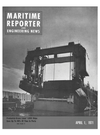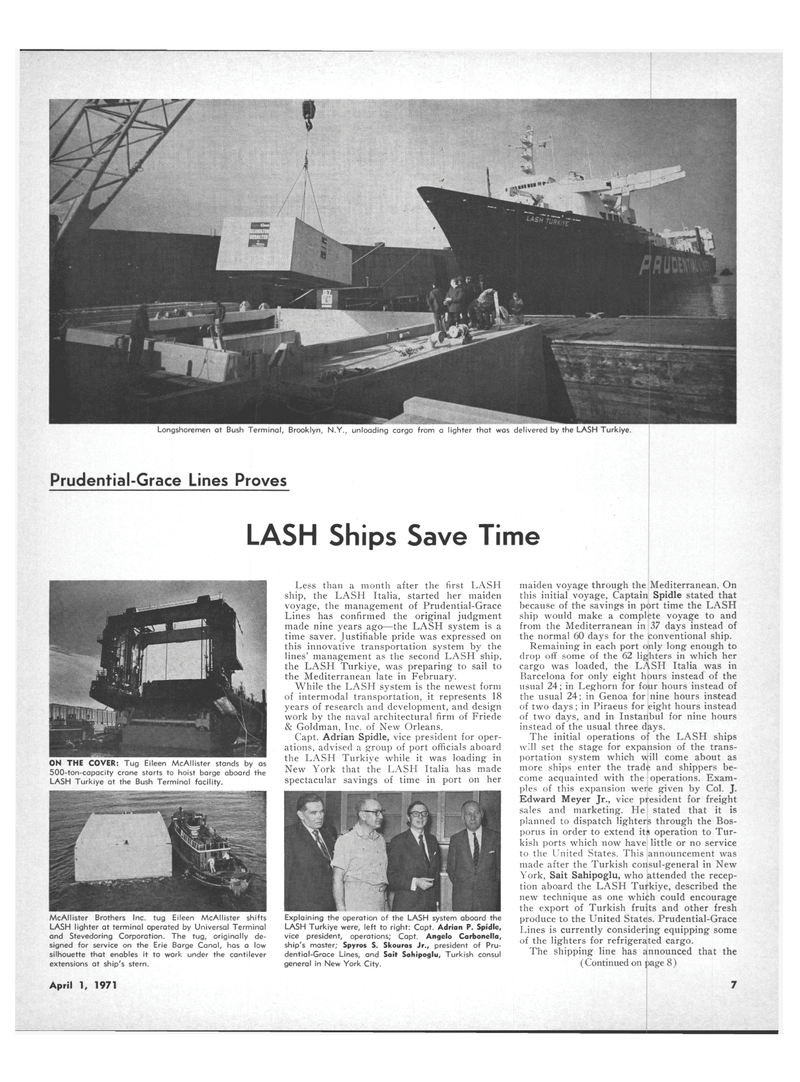
Page 5: of Maritime Reporter Magazine (April 1971)
Read this page in Pdf, Flash or Html5 edition of April 1971 Maritime Reporter Magazine
Longshoremen at Bush Terminal, Brooklyn, N.Y., unloading cargo from a lighter that was delivered by the LASH Turkiye.
Prudential-Grace Lines Proves
LASH Ships Save Time
ON THE COVER: Tug Eileen McAllister stands by as 500-ton-capacity crane starts to hoist barge aboard the
LASH Turkiye at the Bush Terminal facility.
Less than a month after the first LASH ship, the LASH Italia, started her maiden voyage, the management of Prudential-Grace
Lines has confirmed the original judgment made nine years ago—the LASH system is a time saver. Justifiable pride was expressed on this innovative transportation system by the lines' management as the second LASH ship, the LASH Turkiye, was preparing to sail to the Mediterranean late in February.
While the LASH system is the newest form of intermodal transportation, it represents 18 years of research and development, and design work by the naval architectural firm of Friede & Goldman, Inc. of New Orleans.
Capt. Adrian Spidle, vice president for oper- ations, advised a group of port officials aboard the LASH Turkiye while it was loading in
New York that the LASH Italia has made spectacular savings of time in port on her
Explaining the operation of the LASH system aboard the
LASH Turkiye were, left to right: Capt. Adrian P. Spidle, vice president, operations; Capt. Angelo Carbonella, ship's master; Spyros S. Skouras Jr., president of Pru- dential-Grace Lines, and Salt Sahipoglu, Turkish consul general in New York City. maiden voyage through the Mediterranean. On this initial voyage, Captain Spidle stated that because of the savings in port time the LASH ship would make a complete voyage to and from the Mediterranean in 37 days instead of the normal 60 days for the conventional ship.
Remaining in each port only long enough to drop off some of the 62 lighters in which her cargo was loaded, the LASH Italia was in
Barcelona for only eight hours instead of the usual 24; in Leghorn for four hours instead of the usual 24; in Genoa for nine hours instead of two days; in Piraeus for eight hours instead of two days, and in Instanbul for nine hours instead of the usual three days.
The initial operations of the LASH ships will set the stage for expansion of the trans- portation system which will come about as more ships enter the trade and shippers be- come acquainted with the operations. Exam- ples of this expansion were given by Col. J.
Edward Meyer Jr., vice president for freight sales and marketing. He stated that it is planned to dispatch lighters through the Bos- porus in order to extend its operation to Tur- kish ports which now have little or no service to the United States. This announcement was made after the Turkish consul-general in New
York, Sait Sahipoglu, who attended the recep- tion aboard the LASH Turkiye, described the new technique as one which could encourage the export of Turkish fruits and other fresh produce to the United States. Prudential-Grace
Lines is currently considering equipping some of the lighters for refrigerated cargo.
The shipping line has announced that the (Continued on page 8)
McAllister Brothers Inc. tug Eileen McAllister shifts
LASH lighter at terminal operated by Universal Terminal and Stevedoring Corporation. The tug, originally de- signed for service on the Erie Barge Canal, has a low silhouette that enables it to work under the cantilever extensions at ship's stern.
April 1, 1971 7

 4
4

 6
6
